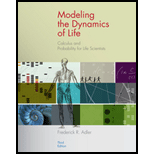
Concept explainers
a.
To find: Formula for the sum of two measurements
a.
Answer to Problem 37E
The sum of two population measurements is
Explanation of Solution
Given:
A population of bacteria consists of two types a , b which grow with time according to relation
Formula used:
The formula for sum of two quantities.
Calculation:
The two measurements of bacteria populations are
The sum of two population measurements is
Conclusion:
The sum of two population measurements is
b.
To find:The derivative of each component of bacteria population.
b.
Answer to Problem 37E
The derivatives of population measurements components are
Explanation of Solution
Given:
The two population measurement components
Formula used:
The derivative of function
Calculation:
The population components are
Their derivatives are
Conclusion:
The derivatives of population measurements components are
c.
To find: The derivative of the sum and check that the
c.
Answer to Problem 37E
The derivative of the sum is
Explanation of Solution
Given:
The sum of population components is
Concept used:
The sum rule of derivatives is
Calculation:
The sum of population components is
Now, the sum of derivatives of measurement components is
Thus, we have
Conclusion:
The derivative of the sum is
d.
To describe: In words what is happening.
d.
Answer to Problem 37E
The population of bacteria represented by the component
The population of bacteria represented by the component
The overall population of bacteria represented by the component
Explanation of Solution
Given:
The components of population measurements are
Concept used:
The function
Calculation:
Since
Since
Since
Conclusion:
The population of bacteria represented by the component
The population of bacteria represented by the component
The overall population of bacteria represented by the component
e.
To graph: The each component and total as function of time.
e.
Explanation of Solution
Given:
The components of population measurements are
Method used:
The graph is sketched using graphing calculator
Graph:
The graphs of components of population measurements

Want to see more full solutions like this?
Chapter 2 Solutions
Modeling the Dynamics of Life: Calculus and Probability for Life Scientists
 Linear Algebra: A Modern IntroductionAlgebraISBN:9781285463247Author:David PoolePublisher:Cengage Learning
Linear Algebra: A Modern IntroductionAlgebraISBN:9781285463247Author:David PoolePublisher:Cengage Learning

